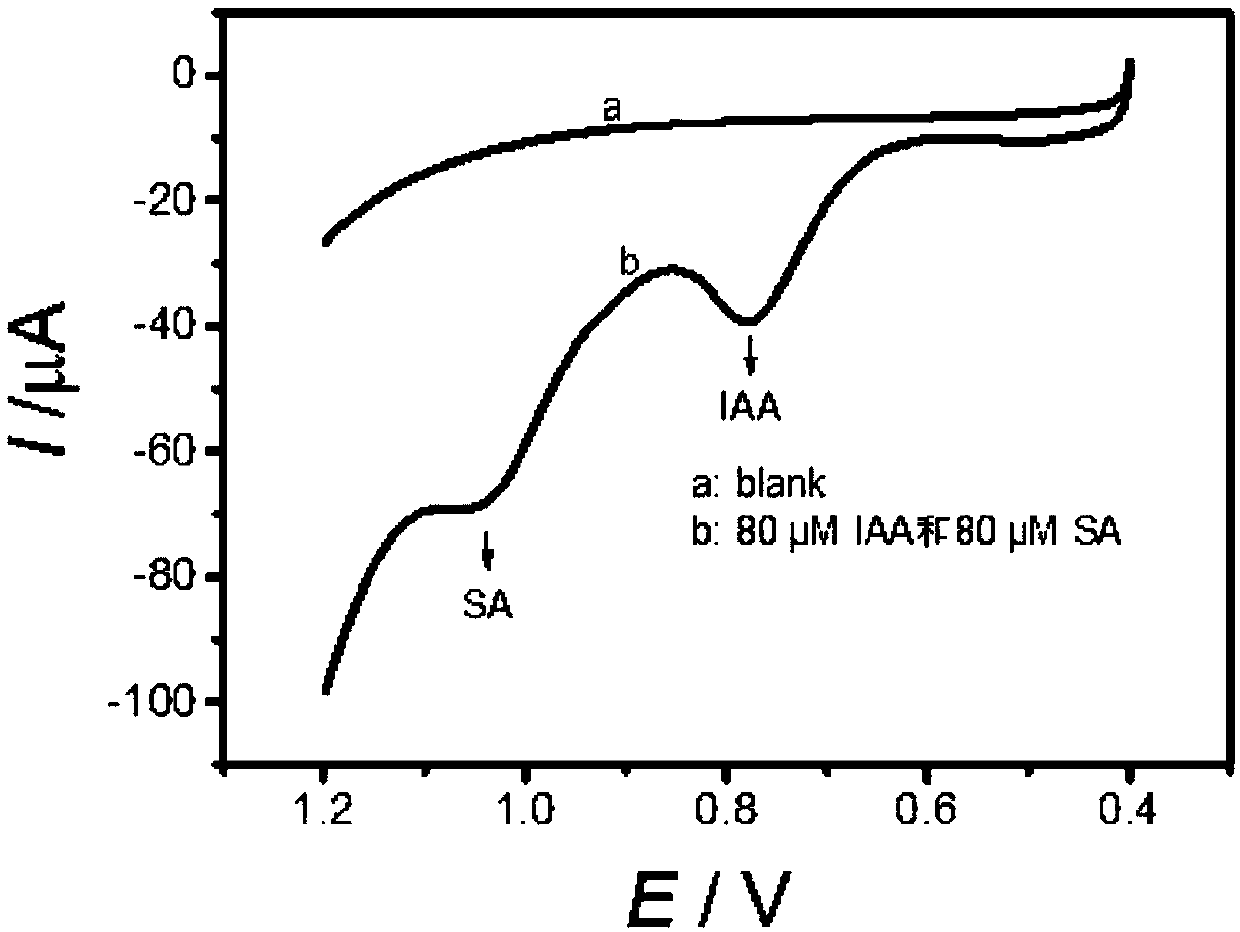Method for detecting indoleacetic acid and salicylic acid and electrochemical sensor used in method
A sensor and electrochemical technology, applied in the field of a method and its electrochemical sensor, can solve the problems of expensive modified electrode materials, few types of functional monomers, and high cost
- Summary
- Abstract
- Description
- Claims
- Application Information
AI Technical Summary
Problems solved by technology
Method used
Image
Examples
Embodiment 1
[0025] Example 1: A method for simultaneous detection of indole-3-acetic acid and salicylic acid and the electrochemical sensor used therefor
[0026] (1) Electrode pretreatment: use 1.0, 0.3 and 0.05μm Al respectively 2 o 3 The powder was polished to a mirror surface, and then ultrasonically cleaned with absolute ethanol and double distilled water. 2 Blow dry and set aside.
[0027] (2) Preparation of buffer: prepare 0.1M NaH respectively 2 PO 4 solution and 0.1M H 3 PO 4 solution with 0.1M H 3 PO 4 Solution adjusted to 0.1M NaH 2 PO 4 The pH of the solution was brought to 2.5.
[0028] (3) Preparation of graphene hydrogels (GHs):
[0029] 10 mL of GO dispersion (3 mg / mL) was sonicated for 20 min, 66 mg of sodium ascorbate was added under sonication, and NaOH or H 2 SO 4 solution to adjust the pH of the GO dispersion to 3.47, and the mixture was sealed in an autoclave and heated at 90 °C for 3 h to form GH.
[0030] (4) Preparation of modified glassy carbon elec...
Embodiment 2
[0039] Example 2: A method for simultaneous detection of indole-3-acetic acid and salicylic acid and the electrochemical sensor used therefor
[0040] (1) Electrode pretreatment: use 1.0, 0.3 and 0.05μm Al respectively 2 o 3 The powder was polished to a mirror surface, and then ultrasonically cleaned with absolute ethanol and double distilled water. 2 Blow dry and set aside.
[0041] (2) Preparation of buffer: prepare 0.1M NaH respectively 2 PO 4 solution and 0.1M H 3 PO 4 solution with 0.1M H 3 PO 4 Solution adjusted to 0.1M NaH 2 PO 4 The pH of the solution was brought to 2.5.
[0042] (3) Preparation of graphene hydrogels (GHs):
[0043] 10 mL of GO dispersion (3 mg / mL) was sonicated for 20 min, 66 mg of sodium ascorbate was added under sonication, and NaOH or H 2 SO 4 solution to adjust the pH of the GO dispersion to 3.47, and the mixture was sealed in an autoclave and heated at 90 °C for 3 h to form GH.
[0044] (4) Preparation of modified glassy carbon elec...
Embodiment 3
[0053] Example 3: A method for simultaneous detection of indole-3-acetic acid and salicylic acid and the electrochemical sensor used therefor
[0054] (1) Electrode pretreatment: use 1.0, 0.3 and 0.05μm Al respectively 2 o 3 The powder was polished to a mirror surface, and then ultrasonically cleaned with absolute ethanol and double distilled water. 2 Blow dry and set aside.
[0055] (2) Preparation of buffer: prepare 0.1M NaH respectively 2 PO 4 solution and 0.1M H 3 PO 4 solution with 0.1M H 3 PO 4 Solution adjusted to 0.1M NaH 2 PO 4 The pH of the solution was brought to 2.5.
[0056] (3) Preparation of graphene hydrogels (GHs):
[0057] 10 mL of GO dispersion (3 mg / mL) was sonicated for 20 min, 66 mg of sodium ascorbate was added under sonication, and NaOH or H 2 SO 4 solution to adjust the pH of the GO dispersion to 3.47, and the mixture was sealed in an autoclave and heated at 90 °C for 3 h to form GH.
[0058] (4) Preparation of modified glassy carbon elec...
PUM
 Login to View More
Login to View More Abstract
Description
Claims
Application Information
 Login to View More
Login to View More - R&D
- Intellectual Property
- Life Sciences
- Materials
- Tech Scout
- Unparalleled Data Quality
- Higher Quality Content
- 60% Fewer Hallucinations
Browse by: Latest US Patents, China's latest patents, Technical Efficacy Thesaurus, Application Domain, Technology Topic, Popular Technical Reports.
© 2025 PatSnap. All rights reserved.Legal|Privacy policy|Modern Slavery Act Transparency Statement|Sitemap|About US| Contact US: help@patsnap.com



